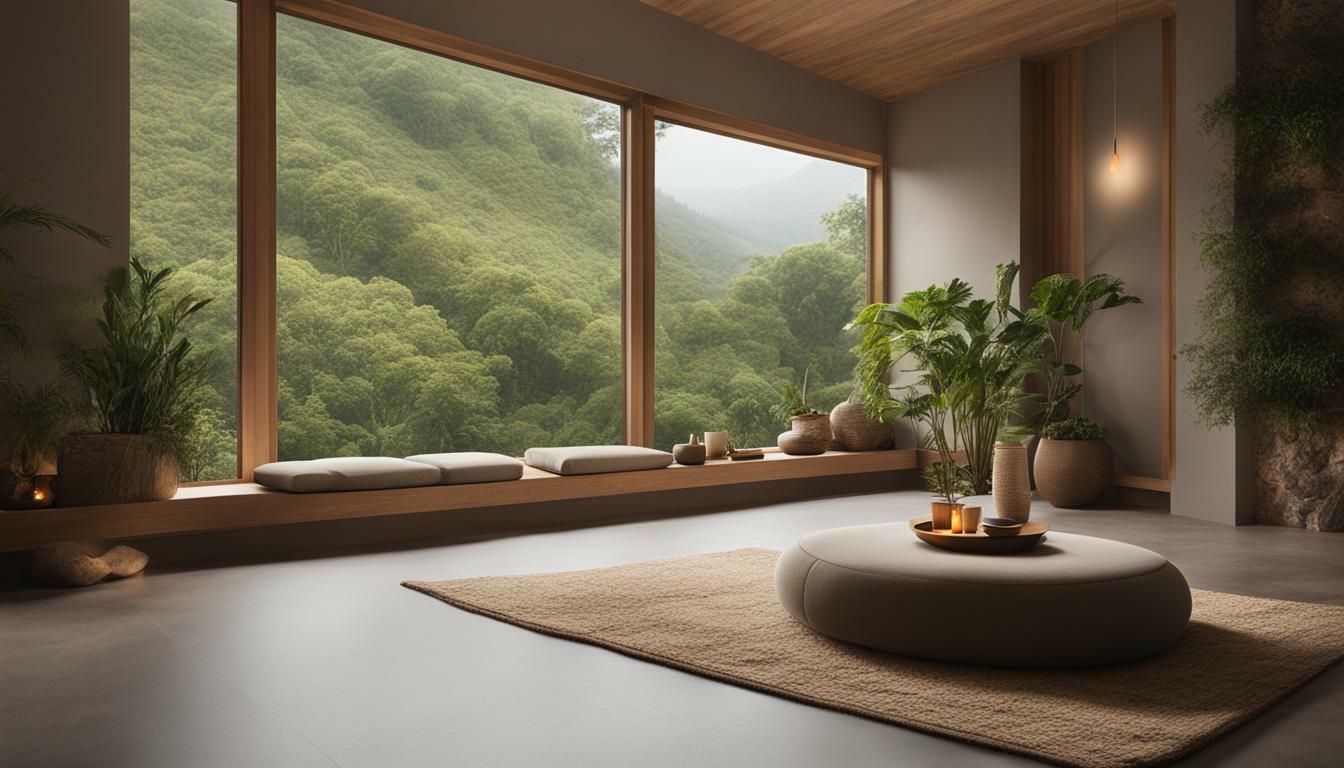Creating a dedicated meditation room in your home can provide a peaceful sanctuary for quiet reflection and relaxation. Whether you choose to designate a small corner or an entire room for this purpose, having a dedicated space for meditation can greatly enhance your practice. In this article, we will explore some ideas and design tips to help you create your own meditation room.
Key Takeaways:
- A meditation room can be a small corner or an entire dedicated space in your home.
- Keep the design simple and clutter-free, incorporating elements that bring you joy and comfort.
- Natural light and natural materials like wood can contribute to a soothing atmosphere.
- Personalize your meditation space with items that hold sentimental value to you.
- Create a serene environment that allows you to disconnect and find inner peace.
Finding the Perfect Space
When looking for the perfect space to create your meditation room, it’s important to consider the essential elements that will help you achieve a sense of peace and tranquility. Creating a dedicated space for meditation allows you to fully immerse yourself in the practice and enhance its benefits. Here are some key factors to consider when finding the ideal location:
- Quiet and Peaceful: Choose a space in your home that is away from noise and distractions. This could be a spare room, a corner of your bedroom, or even a secluded spot in your living room.
- Natural Light: Look for a space with ample natural light, such as a room with large windows or a skylight. Natural light not only creates a calming ambiance but also helps improve focus and clarity during meditation.
- Positive Energy: Pay attention to the energy of the space. Avoid areas that have a lot of clutter or negative associations. Opt for a space that feels open, inviting, and conducive to relaxation.
Once you have identified the perfect location, it’s time to start transforming it into a zen meditation room that reflects your personal style and promotes a peaceful atmosphere. Remember, your meditation room is a sanctuary for your mind, body, and spirit, so make it a space that instantly puts you at ease.
Crafting a Serene Ambiance
Creating a serene atmosphere is essential for a meditation room to be truly effective. Here are some essential elements to consider:
- Comfortable Seating: Choose cushions, meditation chairs, or yoga mats that provide adequate support and allow you to sit comfortably for extended periods. This will help you maintain proper posture and focus on your practice.
- Natural Elements: Incorporate natural materials like wood, stones, and plants to bring a sense of grounding and connection to nature. Consider adding indoor plants, a small fountain, or a bonsai tree to infuse the space with natural beauty and tranquility.
- Aromatherapy: Enhance the sensory experience by introducing essential oils, incense, or scented candles. Opt for calming scents like lavender, chamomile, or sandalwood to induce a state of relaxation and promote mindfulness.
By carefully curating these elements, you can create a zen meditation room that serves as a nurturing sanctuary for your practice. Remember, the goal is to create a space that fosters inner peace and allows you to disconnect from the outside world. Let your creativity flow and personalize your meditation room with meaningful items that resonate with you and inspire a deeper connection with yourself.
Designing Your Meditation Space
Designing your meditation space is an opportunity to infuse your personal style while creating a serene and calming environment. When it comes to meditation room decor, less is often more. Keeping the space simple and clutter-free allows for a clear and focused mindset. Consider incorporating elements that have personal meaning to you, such as cushions, rugs, and throws, to create a cozy and comfortable atmosphere.
Natural elements can greatly enhance the soothing ambiance of your meditation space. You can bring the outdoors in by adding plants or incorporating dried branches. Additionally, pastel hues can create a sense of tranquility, promoting relaxation and mindfulness. Remember, the goal is to create an environment that encourages inner stillness and peace.
Lighting is another important aspect to consider in your meditation space. Natural light is preferable, so choosing a space near a window or skylight can bring a sense of openness and connection to the outside world. To further enhance the calming atmosphere, you may want to add candles or incorporate essential oils for aromatherapy.
Personal touches are essential to make your meditation space truly unique and reflective of your journey. Consider adding items that hold sentimental value, such as diffusers, bells, crystals, or artwork. These elements will not only make the space visually appealing but also deepen your connection with yourself during your meditation practice.
| Meditation Room Decor Tips: |
|---|
| Keep it simple: Less is more when it comes to creating a meditation space. Avoid clutter and choose decor that promotes a calm and serene atmosphere. |
| Incorporate natural elements: Bring nature indoors with plants, dried branches, or natural materials like wood. This will create a soothing environment that fosters a deeper connection with yourself. |
| Add personal touches: Include items that hold sentimental value, such as diffusers, bells, crystals, or artwork. These will make the space feel uniquely yours and enhance your meditation experience. |
| Enhance lighting: Opt for natural light if possible, as it helps create a sense of openness and connection. Candles and essential oils can also add a calming ambiance to your meditation space. |
Designing your meditation space is an opportunity to create a sacred haven for introspection and self-discovery. By infusing your personal style and incorporating the right elements, you can establish a serene and calming environment that promotes mindfulness and inner peace.
Creating a Peaceful Atmosphere
Creating a peaceful atmosphere in your meditation room involves careful planning and organization to ensure a serene and clutter-free environment. By implementing a few key strategies, you can transform your meditation space into a tranquil sanctuary that supports a deep state of relaxation and introspection.
One of the primary considerations for your meditation room setup is to keep the space clean and free of distractions. Remove any unnecessary furniture or items that may disrupt your focus during meditation. A clutter-free environment promotes a sense of calmness and clarity, allowing you to fully immerse yourself in your practice.
Organize your meditation accessories in a way that is both functional and aesthetically pleasing. Consider using storage containers or shelves to keep items such as candles, incense, and meditation cushions neatly arranged. Having everything easily accessible and well-organized will enhance your overall meditation experience and create a sense of harmony within the space.
Another essential aspect of creating a peaceful atmosphere is to establish a consistent daily routine. Set aside dedicated time for meditation and incorporate it into your daily schedule. This regularity will help you establish a deeper connection with your practice and make your meditation room a place of tranquility and solace. Treat this space as sacred and ensure it remains a designated area for relaxation and introspection.
| Key Strategies for Creating a Peaceful Atmosphere |
|---|
| 1. Keep the space clean and clutter-free. |
| 2. Organize your meditation accessories for easy access. |
| 3. Establish a consistent daily meditation routine. |
Personal Touches and Meaningful Elements
Adding personal touches and meaningful elements to your meditation room can help create a sacred space where you can connect with your inner self. These elements can evoke positive emotions and reinforce the intention of your practice. Consider incorporating the following ideas into your meditation space:
- Sentimental items: Display objects that hold personal meaning to you, such as family heirlooms, mementos from meaningful experiences, or gifts from loved ones. These items can serve as reminders of cherished memories and bring a sense of comfort and grounding.
- Inspirational quotes: Place inspirational quotes or affirmations on the walls or in frames to provide a source of motivation and encouragement during your meditation sessions. You can create a beautiful quote wall or choose a single quote that resonates with you.
- Natural elements: Incorporate nature-inspired elements like seashells, stones, or feathers into your meditation space. These items can connect you to the natural world and help create a sense of tranquility and harmony.
Additionally, consider incorporating soothing scents into your meditation room. Essential oils, incense, or candles with calming fragrances like lavender, sandalwood, or chamomile can enhance relaxation and promote a peaceful atmosphere.
Creating a Crystal Grid
One popular way to infuse your meditation room with positive energy is by creating a crystal grid. A crystal grid is a geometric arrangement of crystals that work together to amplify intentions and energy. Here’s how you can create a simple crystal grid:
- Choose a crystal that aligns with your intention, such as clear quartz for clarity or amethyst for peace.
- Select a sacred geometry pattern, such as a flower-of-life or a spiral, to arrange your crystals on.
- Cleanse your crystals by rinsing them with water or smudging them with sage.
- Place your chosen crystals on the sacred geometry pattern, following a specific layout for your intention.
Once your crystal grid is set up, take a moment to connect with the energy of the crystals and set your intention for your meditation practice.
Manifestation Visualization
Visualization is a powerful tool for manifestation. In your meditation space, create a small vision board or manifestation altar. This can be a dedicated space where you place images or objects that represent your goals, dreams, or desires. You can use magazine cutouts, printed images, or handwritten affirmations. By regularly visualizing and affirming your intentions in this sacred space, you can align your energy and attract what you desire into your life.
Remember, your meditation room is a reflection of your inner journey. Experiment with different elements and designs until you find what resonates with you. Trust your intuition and let your creativity guide you as you create a space that supports your meditation practice and nourishes your soul.
Conclusion
Creating a meditation room in your home can be a transformative experience, providing a sanctuary for peace and relaxation in your daily life. It’s a space where you can escape from the busyness of the outside world and find inner calmness.
When designing your meditation space, remember that less is more. Keep the area simple and clutter-free, allowing for a clear and focused mind. Opt for objects and colors that bring you joy and comfort, creating an atmosphere that resonates with your personal style.
Natural elements like plants, wood, and natural light are essential components of a meditation room. Incorporate these elements to create a soothing and calming environment. Consider adding cushions, rugs, and throws to create a cozy and comfortable space that invites relaxation.
Adding personal touches to your meditation room is important. Choose items that have sentimental value to you, such as diffusers, bells, crystals, or artwork. These meaningful elements will make the space feel unique and help you connect with yourself on a deeper level during your meditation practice.
Ultimately, the goal of creating a meditation room is to provide yourself with a serene and peaceful environment that allows you to disconnect from the outside world and find inner stillness. Whether it’s a small corner or a dedicated room, your meditation space should be a place where you can retreat to and find calmness and clarity.
Can Having a Meditation Room Enhance the Experience of Keeping a Meditation Journal?
Having a dedicated meditation room can greatly enhance the experience of keeping a meditation journal. Creating a tranquil and serene environment in your meditation room allows you to fully immerse yourself in the practice of journaling. It fosters a sense of peace and stillness, enabling you to be fully present as you reflect on your meditation sessions. By engaging in this ritual within a designated space, the act of keeping a meditation journal becomes even more profound and meaningful.
FAQ
Q: How do I create a meditation room in my home?
A: To create a meditation room, find a space in your home that can be dedicated to this purpose. Keep the design simple and clutter-free, incorporating objects and colors that bring you joy and comfort.
Q: What are some essential elements for a meditation room?
A: Essential elements for a meditation room include cushions, rugs, and throws for a cozy atmosphere, as well as natural light and materials like wood. Consider adding a table or shelf for candles, essential oils, and other relaxation-promoting items.
Q: How can I make my meditation space more personal?
A: Add items that have sentimental value to you, such as diffusers, bells, crystals, or artwork. These personal touches will make the space feel unique and help you connect with yourself during your meditation practice.
Q: What is the goal of a meditation space?
A: The goal of a meditation space is to create a serene and peaceful environment where you can disconnect from the outside world and find inner stillness. It should be a place where you can retreat to and find calmness and clarity.








